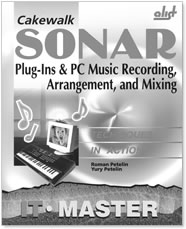A-List Publishing, 2003, ISBN 1-931769-17-6, softcover, US$ 41.95, 692 pages, illustrated; A-List Publishing, 295 East Swedesford Road, PMB #285, Wayne, Pennsylvania 19087, USA; fax (+1) 702-977-5377; electronic mail mail@alistpublishing.com; World Wide Web www.alistpublishing.com
Reviewed by Eric S. Strother
Lexington, Kentucky, USA
 For
many years, Cakewalk has been one of the leading Windows-based sequencing
and digital audio editing software packages. The most recent incarnation
of the software, Cakewalk Sonar, has built on this solid base by becoming
a comprehensive PC-based recording studio. In an attempt to help users
get the most out of the software, Roman and Yury Petelin have written
Cakewalk Sonar: Plug-ins & PC Music Recording, Arrangement, and
Mixing, a comprehensive guide to all of Sonar’s capabilities,
menus, windows, settings, and plug-ins. The 692-page replacement manual
covers everything from the most basic information (opening and saving
files, connecting MIDI equipment and microphones to the sound card), to
more advanced usage (tapping into more sophisticated resources of the
sound card, writing algorithm-based programs to manipulate musical events).
This comprehensive approach is both the book’s greatest strength
and a source of problems.
For
many years, Cakewalk has been one of the leading Windows-based sequencing
and digital audio editing software packages. The most recent incarnation
of the software, Cakewalk Sonar, has built on this solid base by becoming
a comprehensive PC-based recording studio. In an attempt to help users
get the most out of the software, Roman and Yury Petelin have written
Cakewalk Sonar: Plug-ins & PC Music Recording, Arrangement, and
Mixing, a comprehensive guide to all of Sonar’s capabilities,
menus, windows, settings, and plug-ins. The 692-page replacement manual
covers everything from the most basic information (opening and saving
files, connecting MIDI equipment and microphones to the sound card), to
more advanced usage (tapping into more sophisticated resources of the
sound card, writing algorithm-based programs to manipulate musical events).
This comprehensive approach is both the book’s greatest strength
and a source of problems.
Overall the layout of the book is excellent. The authors organize the book around the various menus, toolbars, and windows found in the software, covering each one fully before moving on to something new. This “one-stop” approach allows the reader to obtain focused information on the topic of interest without having to wade through irrelevant material. This does result in some redundancy over the course of the book, but I believe this is the best approach to use. When a user is looking for information on performing a task in the Piano Roll window, she or he likely is not concerned with how those actions are carried out in the Staff window.
The only organizational problem I see is the decision to make the “Getting Started” chapter the second chapter rather than the first. This chapter introduces the novice user to the most basic concepts of the software (loading, saving, and playing files), the different ways of viewing the music, and how to connect MIDI equipment and microphones to the computer. This chapter should certainly appear before the chapter which shows how to configure the software to fit the particular user’s setup and personal preferences. After all, it does not make sense for the beginner to go through the steps to select which MIDI device to use if she or he has not been through the steps to connect MIDI devices to the computer.
The text is mostly clear and easy to understand. Since the authors attempt to make the book accessible to novice users, the language is not overly jargoned and is written in simple (although sometimes overly so) English. They not only explain how to use the different features but also how the more advanced features work to produce the intended results. There are a number of places that make me wonder how closely the text was edited before publication, as there are some spelling errors that a standard spell-checking utility should have caught (such as “are’t” instead of “aren’t”) and syntax problems which sometimes make the text read like a weak translation into English.
The authors supplement the text with an abundance of illustrations, mainly screen-shots, to help the reader better understand the descriptions. This does lead to a few problems, the biggest one being that the illustrations often appear as many as two pages away from the corresponding text. This does happen occasionally in many books and is often unavoidable; however, the frequency with which it happens in this book could have been avoided by consolidating some illustrations which show similar information. For example, there are six illustrations which show the “Assign Instrument” dialog box with different items highlighted when it should be sufficient to simply show one configuration and trust that the reader will be able to follow the text for a description of the process to create a different configuration.
Overall this is an excellent reference book for anyone working with Cakewalk Sonar. I believe it is more useful as a reference book than as a way to learn the software. The inclusion of tutorials by starting a project at the beginning and following it through the book would have made the book more novice-friendly, and cleaning up the text and simplifying the illustrations would have made it easier for everyone to follow.